When I get into a hobby, I fully get into it, and BBQ has been no different than anything else that I’m interested in. I’ve done a lot of reading about BBQ through websites, forums, blogs, books, and pretty much anything I can find. The more I read, the more I noticed that there isn’t one specific way of approaching BBQ. There are different regional styles, different flavour profiles and sauces, different techniques, and a wide variety of different equipment that is used, all falling under the umbrella term of BBQ. I believe that reading about something is one way to learn, but that nothing is as effective as actually doing it. To that end, I’ve been trying out many different flavours and techniques in my own BBQ.
I recently did an experiment cooking pork butts a few different ways to try some different techniques with foiling and injections. I wanted to see how different techniques affected the final product, and exactly what the differences would be. I’ve tried different techniques before, but never at the same time, and I feel like it’s hard to really do a proper comparison without being able to directly compare two different samples within a short time. In this experiment, I wanted to see the differences with a couple of specific techniques: foiling, and injecting.
Foiling, also known as the Texas crutch, is a technique used with BBQ to speed up cooking, preserve moisture, and keep the colour of the meat from getting too dark. This is done by using foil and tightly wrapping the meat part way through the cook, and optionally adding additional liquids and flavourings to the foil. The foil acts like a barrier around the meat, braising it in it’s own juices combined with whatever else is added. With a pork butt, this would be done when the internal temperature is about 150f – 160f. In this experiment, I wrapped with aluminium foil and added apple juice to the foil.
Injecting is taking a special meat injecting needle and using it to inject a flavoured liquid directly into a meat before it is cooked. This adds flavour deeper down into the meat that otherwise wouldn’t be reached by a surface flavouring such as a sauce or rub. The injection can also contain phosphates, which help the meat retain moisture throughout the cooking process. For this experiment, I used Butcher BBQ Pork Injection.
I cooked four pork butts, each between 2.5 to 3.5 pounds. I used different #’s of toothpicks to mark the butts and to tell them apart.
- No injection, no wrap
- No injection, wrapped
- Injected, no wrap
- Injected, wrapped
I cooked the four butts between 250f to 275f on my drum smoker, using Maple Leaf hardwood lump charcoal, and a mix of hickory and cherry wood chunks. Each butt was pulled when I could wiggle the blade bone free and it came out cleanly, and for each butt, the internal temperature was around 200f – 205f when that was possible.
The 2 butts that were foiled finished a couple of hours before the non-foiled butts, due to the foil speeding up the cooking process. When each butt finished, I let it rest for 30-60 minutes, then pulled it, tasted it, and took notes. Here’s the summary of the comparison:
- No injection, no wrap
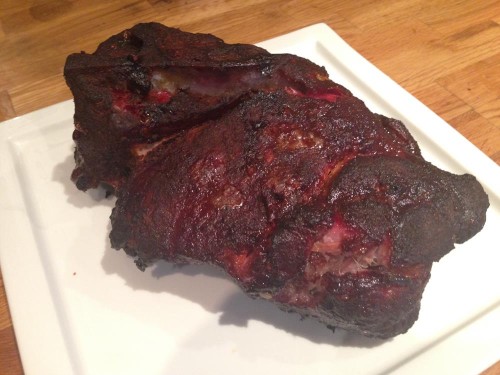
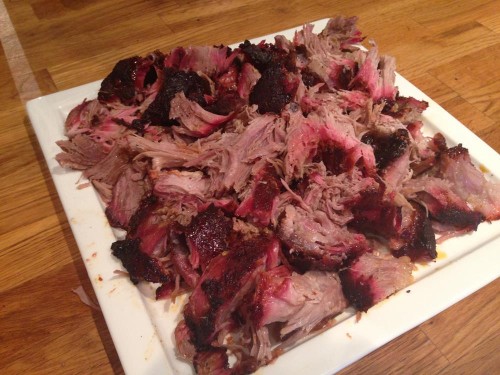
- Appearance: Deep mahogany / dark brown colour, crisp looking bark
- Taste: Bark and the meat directly under it had the strongest flavouring, with the meat further in having more of a pure pork flavour with little flavour from the rub
- Tenderness: Bark crisp looking but not overly crunchy, nice texture contrast between bark and meat, meat very tender and moist, driest of the four
- No injection, wrapped

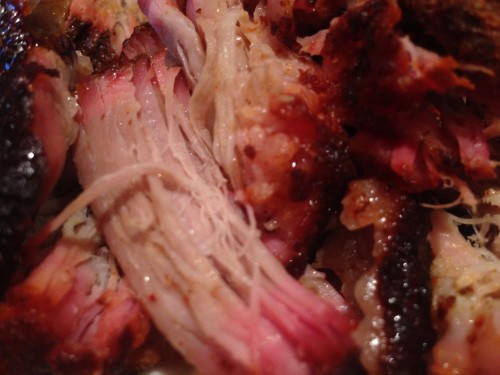
- Appearance: Lighter mahogany colour, soft bark
- Taste: Bark and the meat directly under it had the strongest flavouring, with the meat further in having more of a pure pork flavour with little flavour from the rub
- Tenderness: Meat very tender and moist, bark very soft, of the four, this was the second in terms of moistness/tenderness
- Injected, no wrap
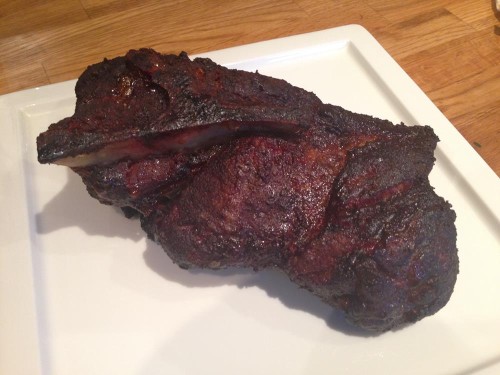
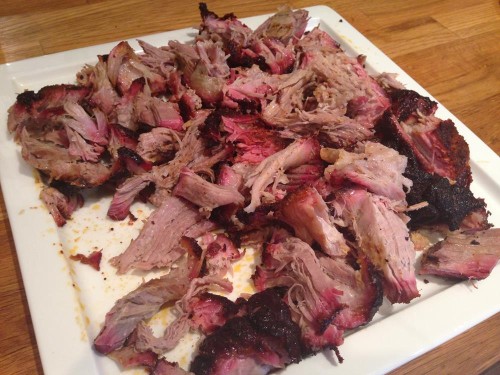
- Appearance: Deep mahogany / dark brown colour, crisp looking bark
- Taste: Bark and the meat directly under it had the strongest flavouring, with the meat further in having a subtle flavour as well – not overpowering the pork flavour, but another layer on top of it
- Tenderness: Bark crisp looking but not overly crunchy, nice texture contrast between bark and meat, meat very tender and moist, of the four, this was third in terms of moistness/tenderness
- Injected, wrapped

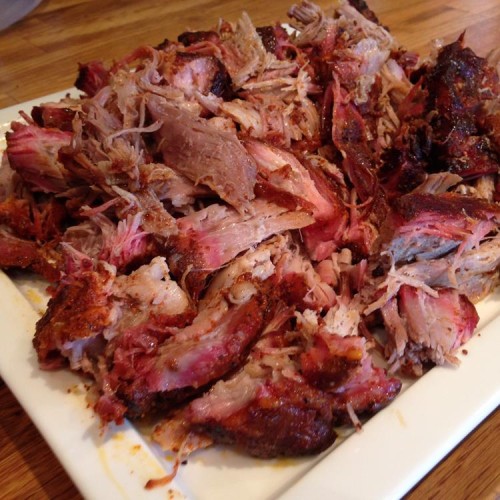
- Appearance: Lighter mahogany colour, soft bark
- Taste: Bark and the meat directly under it had the strongest flavouring, with the meat further in having a subtle flavour as well – not overpowering the pork flavour, but another layer on top of it
- Tenderness: Meat very tender and moist, bark very soft, of the four, this was the most tender and had the most moisture in it
So, in summary, here’s what I observed:
- Foiling cuts down cooking time and improves moisture and tenderness, but at the cost of bark
- Injecting adds flavour and moisture, and in my opinion has no negative effect
- Foiling alone adds more tenderness and moisture than injecting alone
The most important thing I noticed was that once pulled and mixed together, the finished pulled pork from all four of the different meats was delicious, tender, and juicy. All four of them were in my opinion, good BBQ. While tasting the different samples, I really had to look closely to notice the differences, and the differences were very subtle.
With foiling, I think it’s more of a personal preference. If you like a dark, crispy bark, and you’re not strapped for time, then don’t foil. If you want to preserve a certain colour and moisture level, say for a competition turn in, then it makes sense to foil.
With injection, I think that it’s a must. It gets flavour deep into the meat that a regular rub and sauce combo just can’t do. In my admittedly limited experience, I don’t see any disadvantages to injecting, and it just makes sense to me. For a home cook, any of these combinations will give you delicious and tender pulled pork. For a competition, I’ll probably be going with foiling and injection to get as much flavour and tenderness in the meat as possible.
I still have some more experiment ideas in my head for pork butts, and will get to them eventually – next up: home made injection vs Butchers BBQ with water vs Butchers BBQ with apple juice, and wrapping with foil vs wrapping with butcher paper.

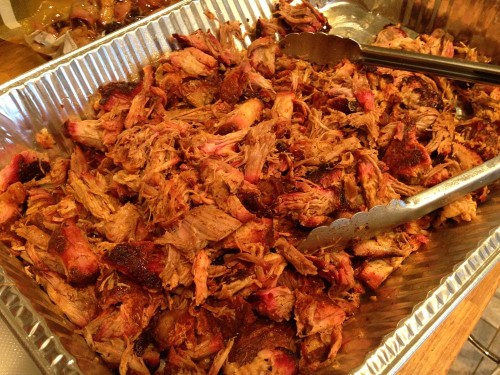
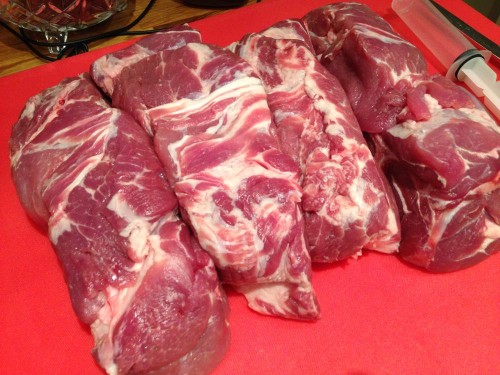
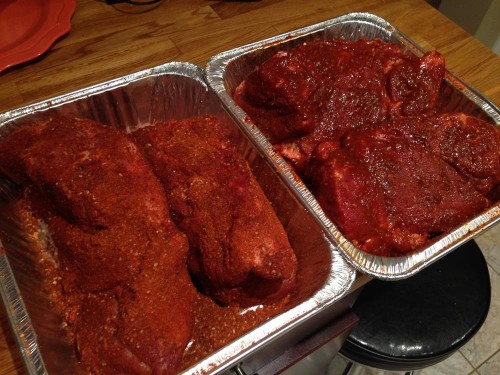
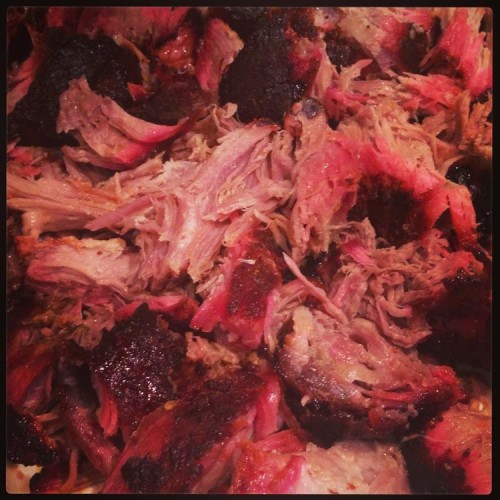
Thanks for posting these results. Did you notice anything in terms of yield/weight loss that was substantial between the 4 butts?
I didn’t think to measure weights for the before / after – my guess would be that the unfoiled butts would yield slightly less weight without as much retained moisture.
I thought your analysis was spot on. I have done all of those differences and came to the same conclusion. I was surprised by you using Butchers injection, I was very slow in adopting injecting. Butchers injection was really good but too salty for my taste. I have diluted it with water and apple juice, I like the sweetness from the juice.
Thanks for your effort and work.
Thanks – I was quick to adopt it from all the reading I’ve done about injections, and from talking to other competitors about it. I agree on the salty flavour – definitely going to cut it with juice next time.
Great analysis! On to the next round of trials